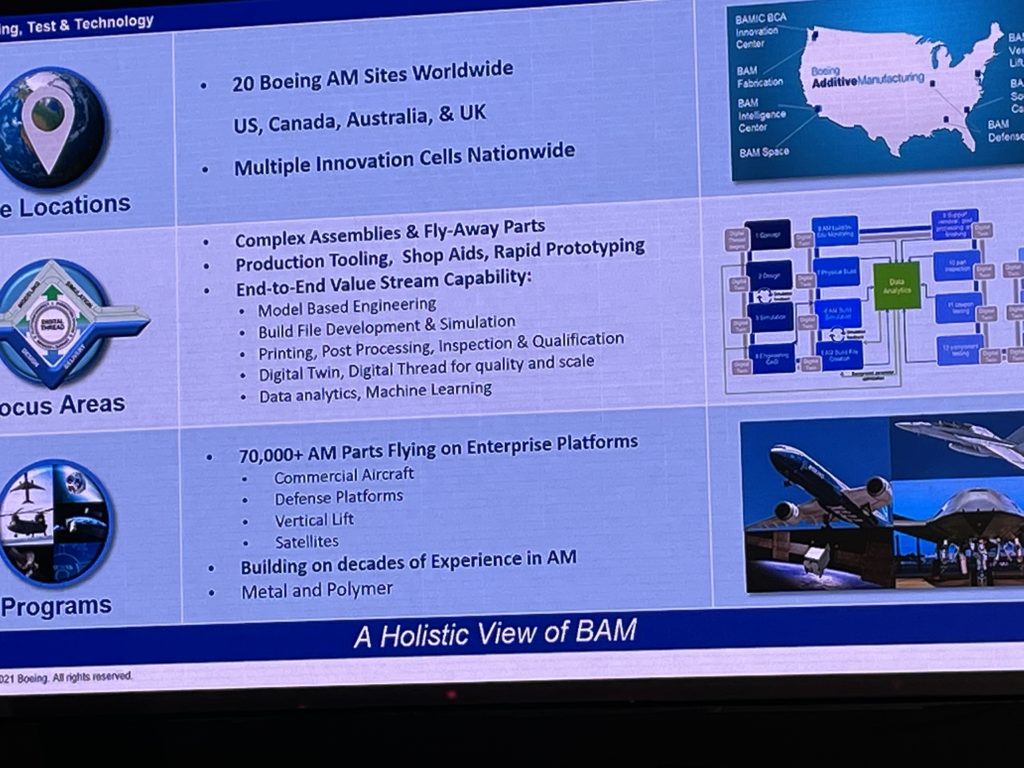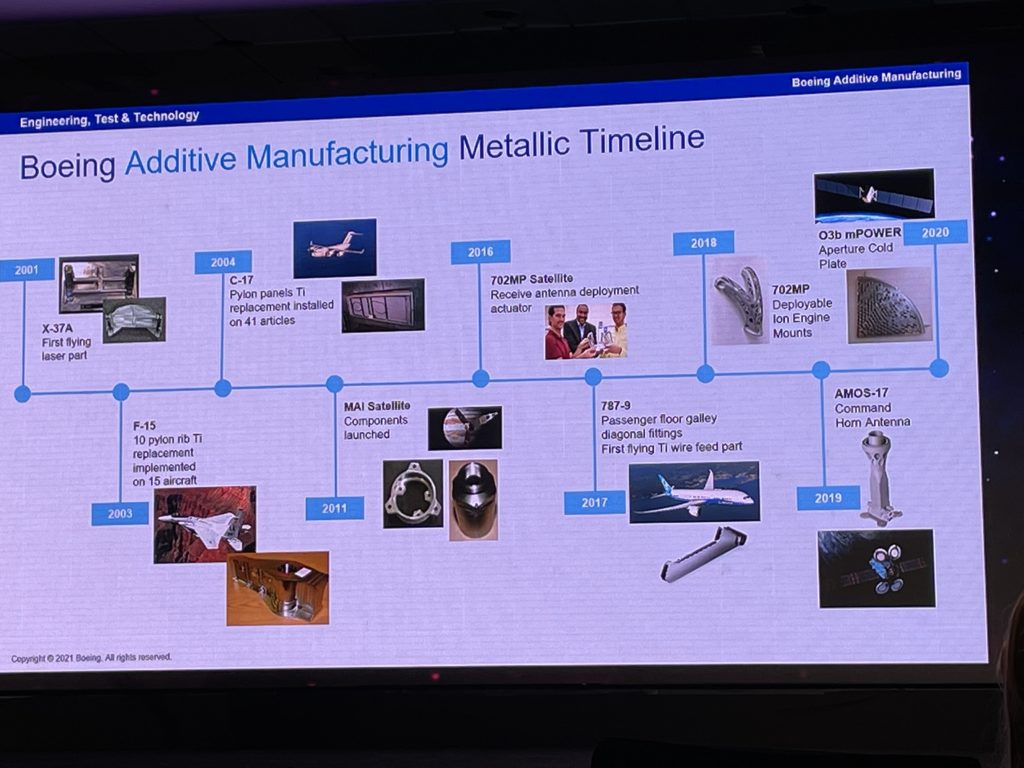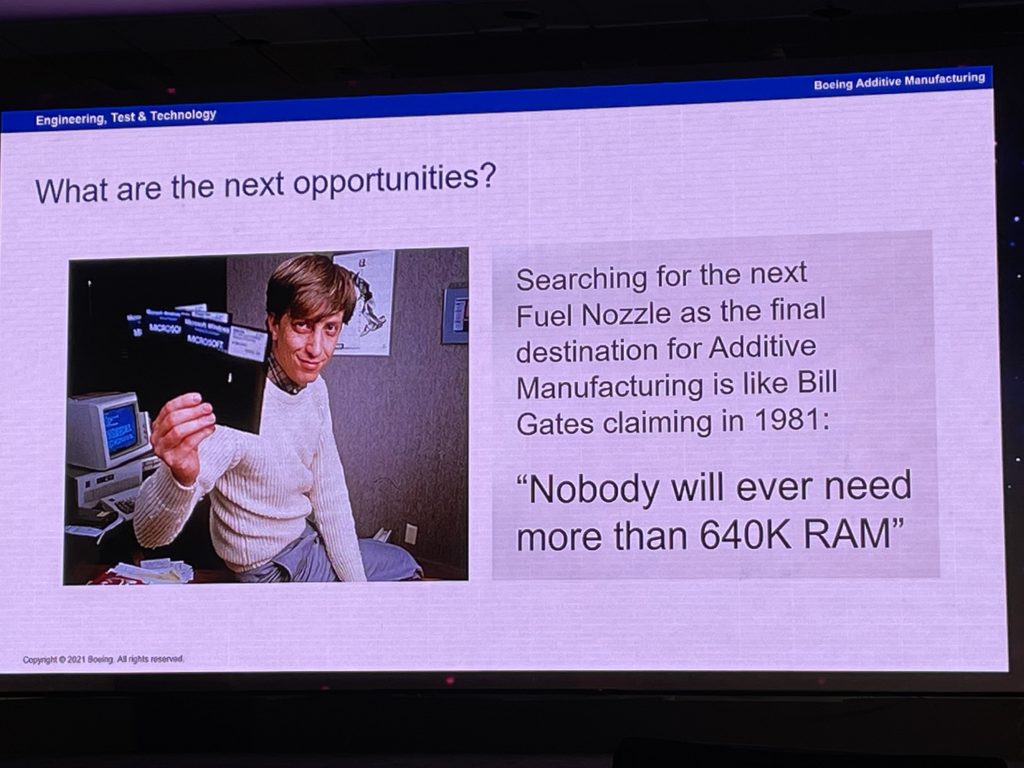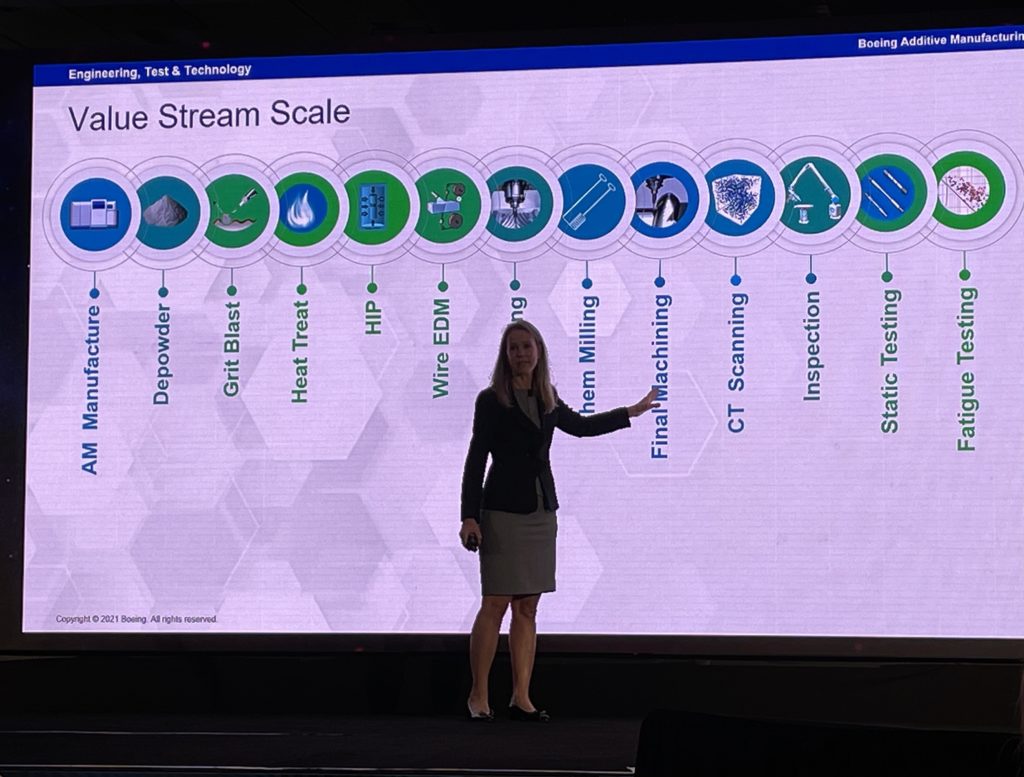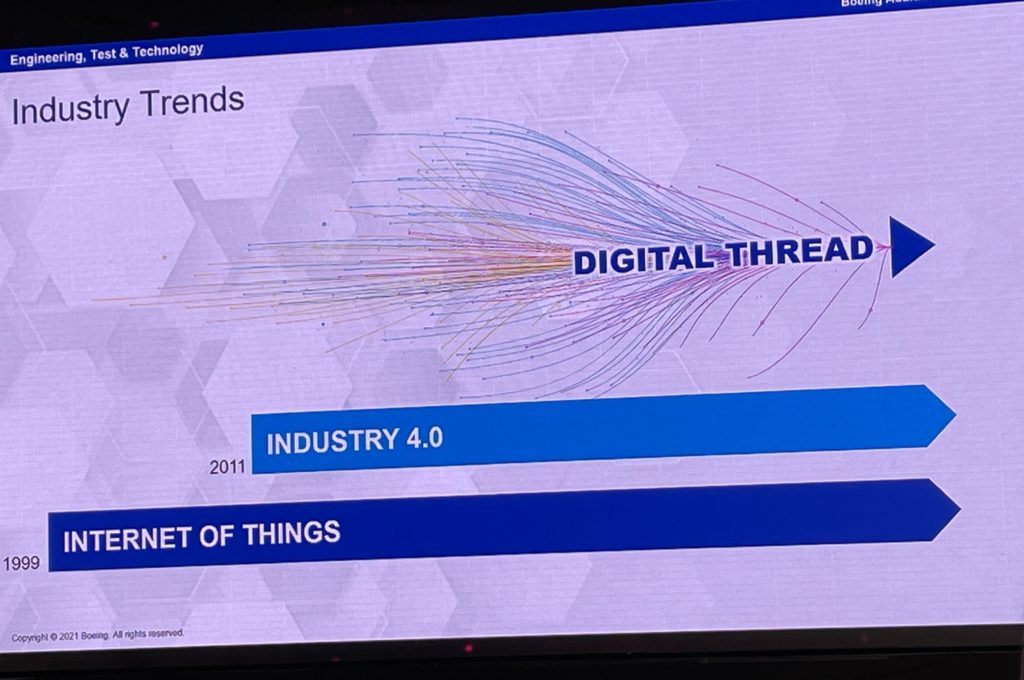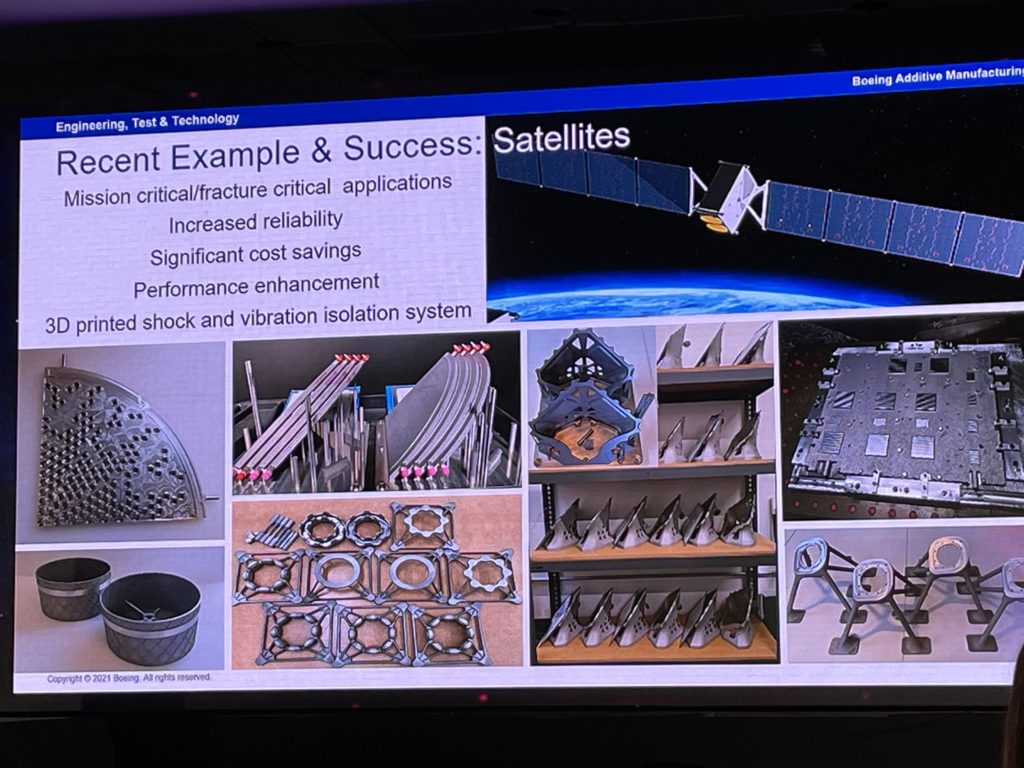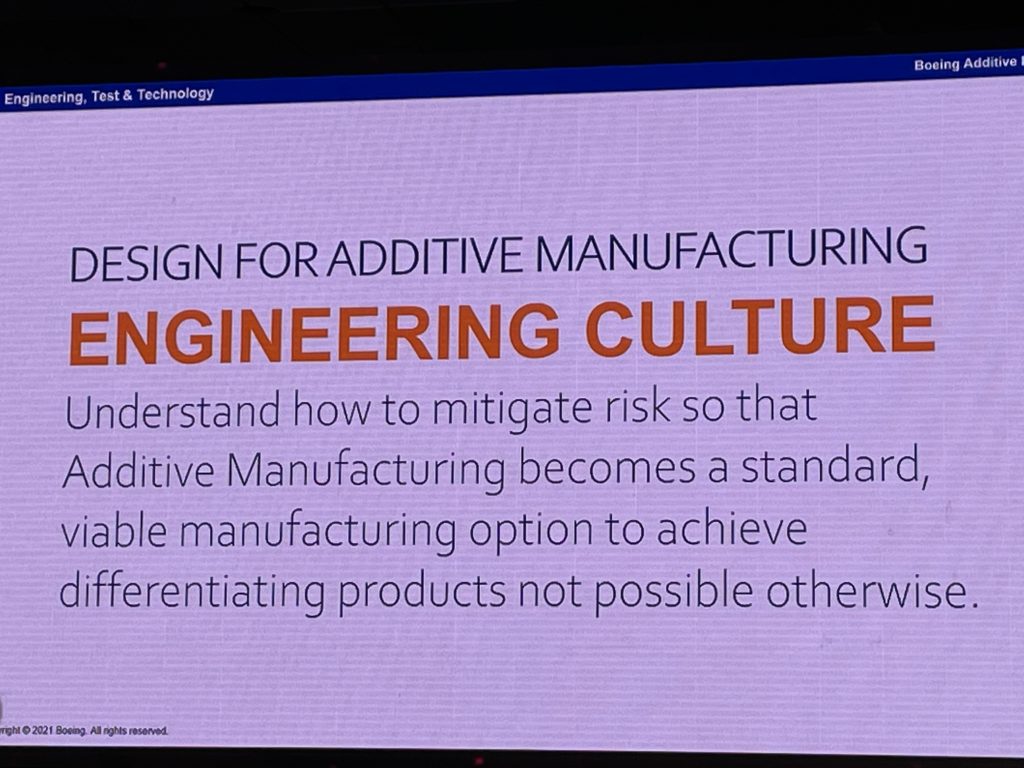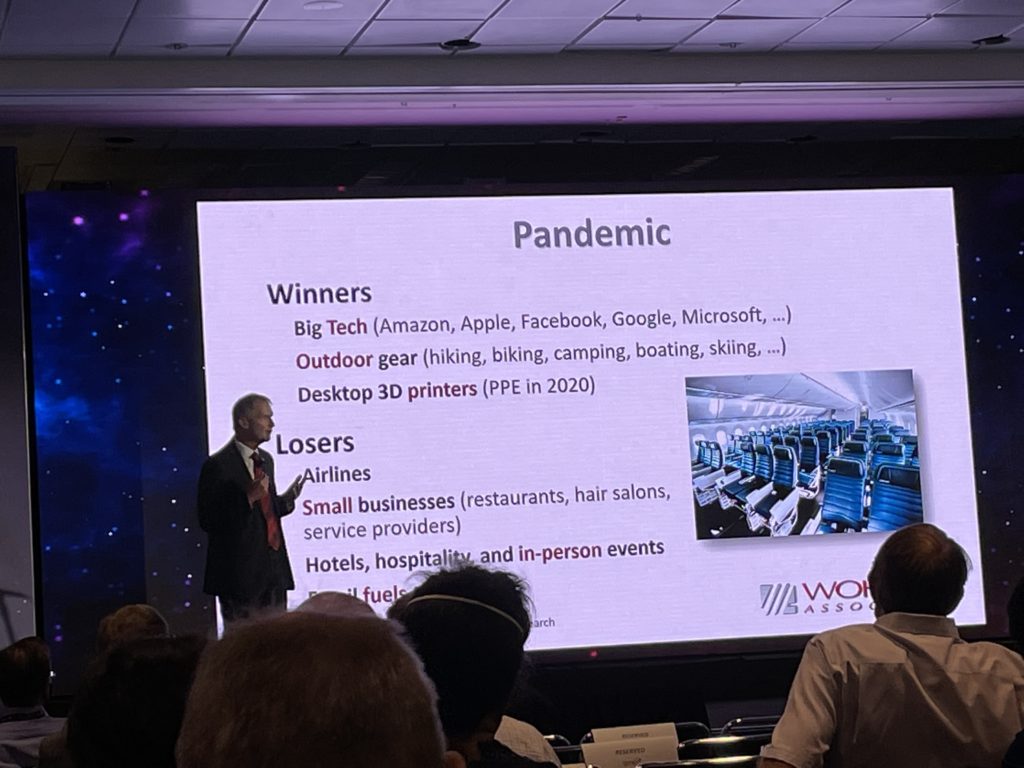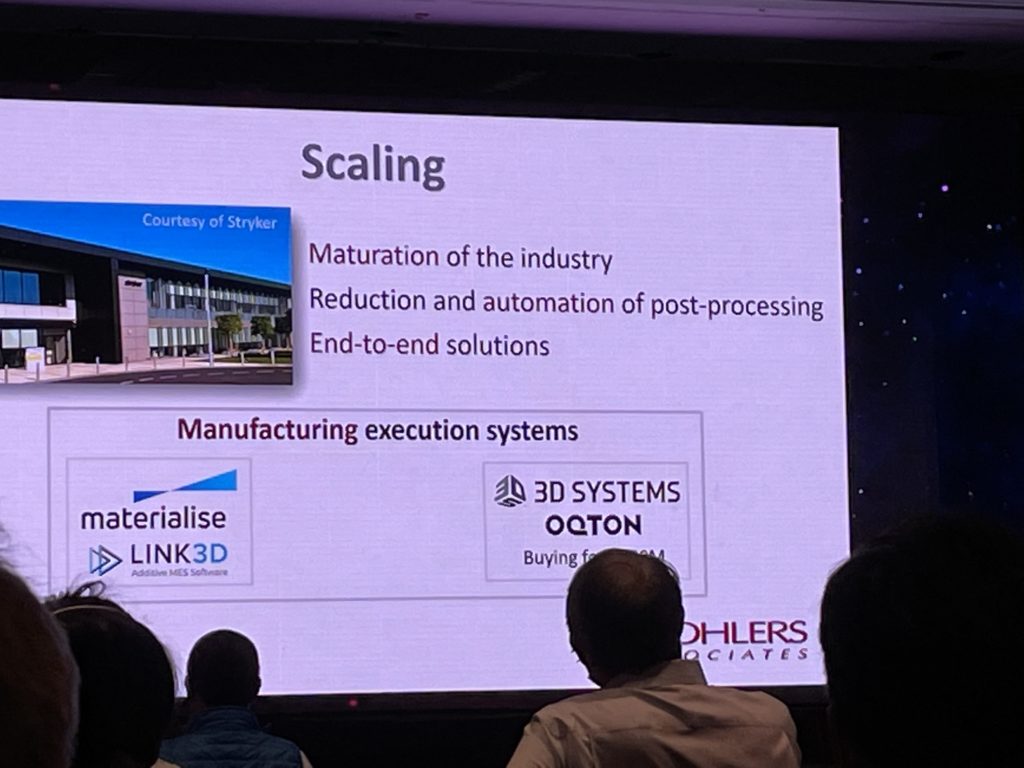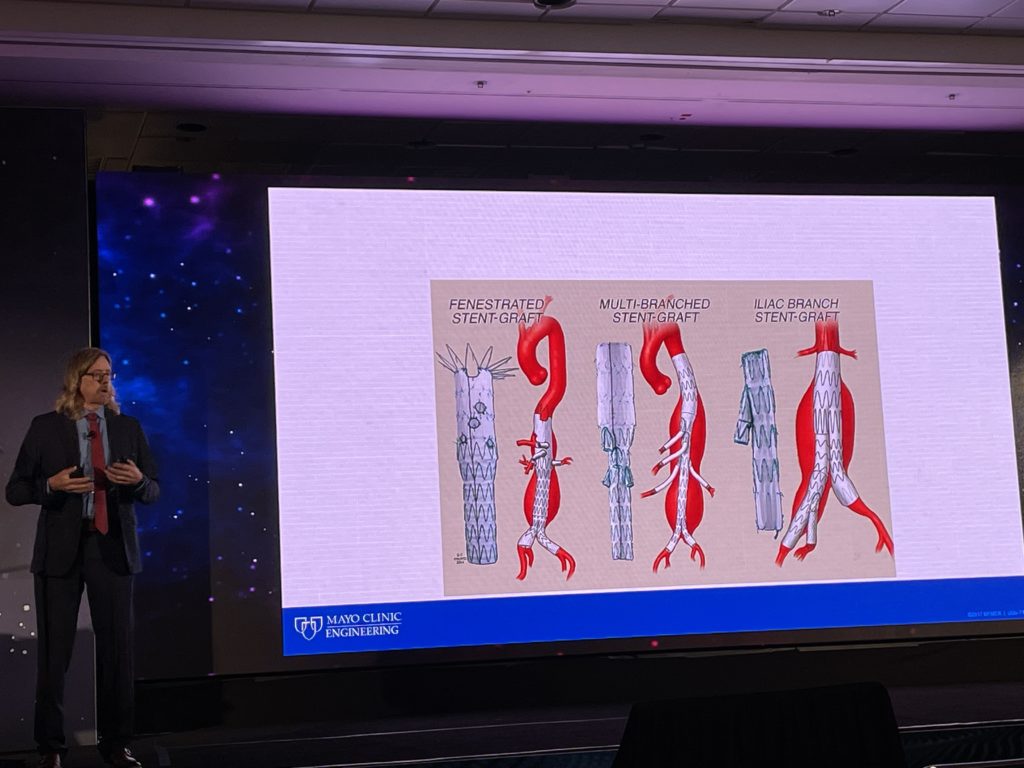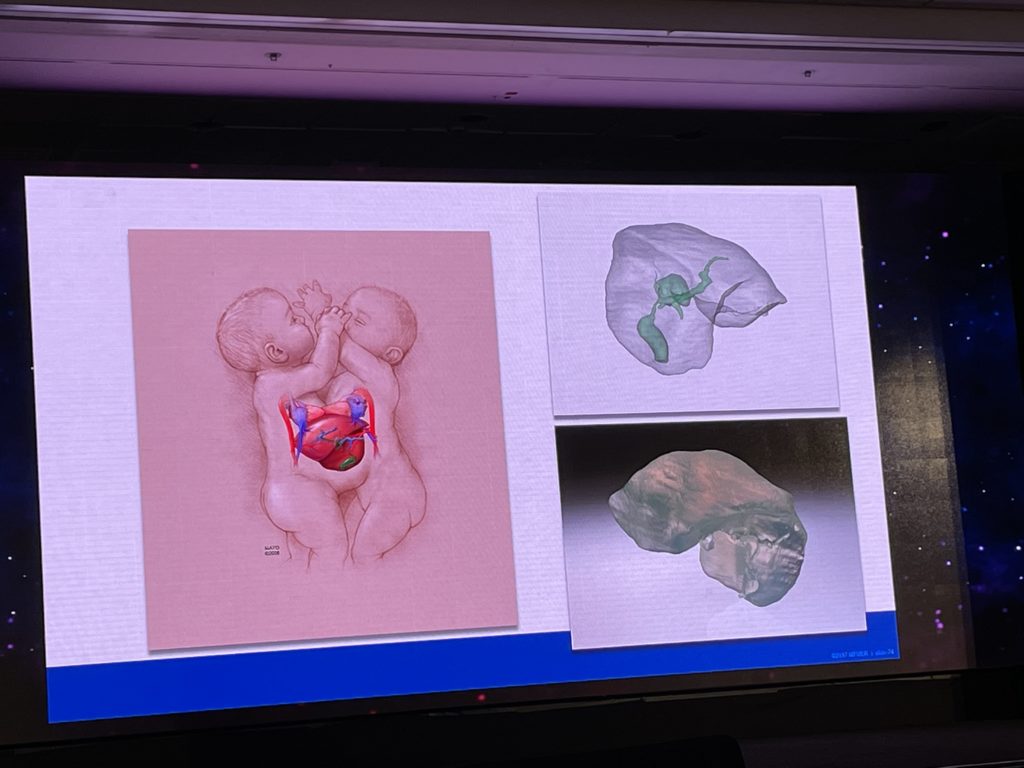At the start of SME’s 30th year of RAPID + TCT, widely known as North America’s largest, most important additive manufacturing event, AM consultant and writer Todd Grimm got things started on the Main Stage by informing the attendees about several industry highlights that had just been revealed that morning, including BMF’s new microArch S230 printer, new materials from Kennametal, 6K Additive, and Stratasys, the new FS237M printer from Farsoon, new software from Covestro, new partnerships for Dyndrite, and more.
SME’s CEO and Executive Director Bob Willig came onstage next and thanked the gathered attendees of the AM industry—he had cervical spinal fusion surgery this summer, and found out afterwards that his disc spacer had been 3D printed; just in case we needed yet another example of the technology’s numerous applications!
Then he introduced the first RAPID keynote speaker, Melissa Orme, PhD, the vice president of Boeing Additive Manufacturing. She started things off by saying something that I’m pretty sure most of us agreed with:
“It’s so nice to not be speaking into a computer for once.”
Amen to that.
She explained that in her presentation, “How AM is Disrupting the Aerospace Industry: Opportunities and Challenges on the Road Ahead,” she would be discussing scale, product differentiation, sustainability, Industry 4.0, industrialization, people, and training. Orme said that Boeing, which has 20 AM sites around the world, focuses on aircraft parts in both metal and polymer, as well as using the technology for teaching aids, tooling, and research mock-ups.
“We see ourselves as an accelerator of product development at Boeing,” she said, noting that the company has more than 70,000 3D printed parts currently flying the friendly skies.
After putting up a timeline of Boeing’s use of metal AM, she also noted a major aviation milestone—GE Additive’s 3D printed LEAP fuel nozzle, an “awesome contribution in 2015” that resulted in 25% weight reduction and consolidated 20 parts into just one.
“Even more recently, GE gained FAA approval for 228 metal turbine blade parts 3D printed on Arcam EBM systems,” Dr. Orme said, noting that these parts resulted in a 10% increase in engine fuel efficiency and a 30% reduction in weight.
Weight reduction is critically important when it comes to aerospace applications, and not just because it’s basically a metal tube that’s carrying people up in the air and needs to remain there; lightweighting can also make aircraft and automobiles more energy efficient as well.
“So what’s next?” Dr. Orme asked the room.
She showed us the different ways that additive manufacturing can add value to an organization: programming, products, and parts.
“I like to look at product value, and that is really what I want to talk about today. When we use additive manufacturing to design in those small conformal spaces to create components, and segments of products that can’t be made traditionally…that’s what we’re really working on at Boeing.”
In terms of product differentiation, additive manufacturing is about more than just making a slightly better part and sticking it into an airplane. Part replacement alone isn’t enough to make a good business case for AM—companies need to focus on using the technology to shape future programs, significantly improve the functionality and performance of a part, and set up a strategy that allows for adaptation to a fast-moving environment of product development.
To that last point, she pulled up a slide showing some of the major metal 3D printing development milestones, including the first DMLS printer in 1994, powder bed enhancements, and more.
“We have to keep our minds open for what’s next, and we have to be able to face technology leaps with agility,” Dr. Orme told the attendees.
Moving on to how organizations can scale technology, she explained that it’s not just about purchasing 50 3D printers and sticking them on the factory floor. Instead, a framework for equivalency needs to be created.
“What I mean is creating a database, so we can leverage all that data we’ve already created,” she explained. “That doesn’t really exist, and we really need to create that so we can continuously adopt new technologies.”
Even more important when adopting new technologies, companies need to make sure that the source material is consistent, the material being created with the machines is consistent, and that post-processing is automated, rather than applied with “brute force.” Consistency is key when it comes to achieving a reliable, repeatable performance.
“We need to hire the right people with the right skillsets and train them, and we need to create a digital infrastructure so we can collect all that data and connect it to the digital thread,” Dr. Orme continued.
“Everything we need to do has to be focused on repeatability and reliability. That is the mantra for additive manufacturing in the aerospace sector.”
So in order to get there, we obviously have some hurdles to get over, and the first has to do with industrialized printers.
“If I’m opening up two of the same machine, they need to have the same ducting, the same wiring, the same bill of materials, and so on. Otherwise they’re two different machines,” Dr. Orme said. “This needs to be improved.”
In a field where regulations and certifications are of the utmost importance, I’d say that’s almost an understatement.
Another hurdle is better access and data to management—how do you manage the data, what do you do with it? Dr. Orme noted that the protocols between OEMs can vary, and that it would be great if there was just one standard data format for all OEMs. Yet another hurdle to overcome is design allowables.
“Without design allowables for aerospace, there’s a lot of testing going on, and that testing costs money, so we’ve just eroded that business case,” she said. “So we have design allowables, which is a really large data set. If we have this statistical data of this machine and our powder suites, we can certify by analysis, and there’s much less testing and much better business cases.”
Risk reduction is another very important hurdle to cross, especially in aerospace, as the engineers are trained to design with reduced risk.
“It’s our job to create the data for them, to do the homework and show them we understand the process and how to mitigate any risk and make them comfortable. That’s the only way they’ll feel comfortable designing for additive in an additive-only solution, and not keep a backup plan. They’re not going to make an additive-only solution until we’ve done our homework that says, every single time you print you’ll have the same part,” she stated.
Dr. Orme said that the digital thread is something that Boeing is really working on, as it allows them to collect all the data, put it all together, and create analytics.
She pulled up a slide with a few examples of Boeing’s 3D printed parts, including powder bed fusion parts for satellites, and listed a few of the positive results, including increased reliability, major cost savings, and performance enhancement.
“But we really need to do more than just create parts—we really are looking for that program value,” Dr. Orme said. “That comes back to engineering culture, which for me is one of the most important things. We need to have done that homework and have that deep understanding to mitigate risk, so that additive manufacturing can be a viable manufacturing option.”
Wrapping up, Dr. Orme quoted American writer William Faulkner, who once said, “You cannot swim for new horizons until you have courage to lose sight of the shore.”
“To really embrace additive, you have to let go of your backup manufacturing plan,” she concluded. “But we need to do our homework in order to get there.”
I ended up referring back to Dr. Orme’s keynote presentation many times in my meetings with various companies during RAPID, especially in terms of “doing the homework” and making sure that everything is repeatable and reliable, and how machines need to be the same inside and out, in order to ensure risk reduction.
The next morning, industry expert Terry Wohlers, Dr. h.c., FSME, presented his keynote presentation, though I unfortunately missed the first ten minutes of it. President and Principal Consultant of Wohlers Associates, Inc., as well as a principal author of the popular Wohlers Report, Wohlers speaks at many AM events, reporting on the state of our industry during previous RAPID events as well as this year’s event.
When I walked into his presentation, “An Industry 30+ Years in the Making,” Wohlers was telling the attendees that 3D printing has grown 27% on average every year for the last ten years, “so it’s a strong industry.” During the beginning of the COVID-19 pandemic in 2020, he noted that our industry “had some winners,” such as outdoor gear for hiking and biking, big tech, like Amazon, and desktop 3D printers for making PPE. But, we also had some “losers,” like small businesses, the fossil fuel industry, airlines, and hotels.
“When we learned how to meet without traveling last year, some people got quite good at it,” he said, bringing up a slide showing an example of a virtual event series Wohlers Associates participated in last year. “I’ve never had so many Zoom meetings in my life.”
I’m pretty sure everyone in the room felt the same way.
“If we divide the industry into products and services, services really powered the additive manufacturing industry last year, along with system sales,” Wohlers said.
He said that in 2020, there were 228 manufacturers worldwide selling industrial 3D printers, and luckily, some of the smaller players reported enough sales during the pandemic for the industry to avoid a decline. Wohlers Associates asked 124 service providers and bureaus, from 27 countries, which AM processes they found to be most profitable, and the top contender was literally the “Other” category, followed by HP and EOS. This is a definite indicator that those smaller AM companies are seeing a more sales, which Wohlers said is “significant.”
In materials news, he explained that polymer powders such as nylon caught up to regular polymers last year, and that across the 52 companies around the world that provide metal powders, aluminum is now the most popular, which is a change. This wasn’t the first time during RAPID that I heard aluminum being discussed, and it definitely wasn’t the last. Wohlers also said that composite materials are on the increase, and that there’s a real opportunity at the moment for composite-based systems. Later, during the Q&A, someone asked him to clarify what he meant by this.
“It seems to me the opportunity is much bigger than what’s been delivered today,” he answered. “It’s not easy to make totally isotropic parts, which you don’t always have to do, but wouldn’t it be nice if you could? I think composite systems will definitely grow.”
Moving on to scaling, Wohlers said that in terms of maturing the industry, reduction and automation of post-processing are important, in addition to end-to-end solutions. Manufacturing execution systems (MES), like Link3D and Oqton, are necessary support platforms to make these solutions work.
Even though last year was unprecedented on so many levels thanks to COVID-19, investments increased from $1.2 billion to $1.3 billion in 2020. Wohlers listed several examples, including Protolabs purchasing Hubs for $320 million and Nikon acquiring Morf3D for about $91 million.
“Desktop Metal is on a buying spree, purchasing five companies, including EnvisionTEC and ExOne, and with five more in the queue,” he said.
3D Systems announced earlier this summer that it was selling its On Demand Manufacturing business for $82 million, and that deal was actually finalized this week. Wohlers noted that the company had purchased a total of 50 other companies from 2009-2015, 17 of which were service providers.
With acquisitions and investments come IPOs, and Wohlers asked if anyone wanted to take a guess as to how many companies announced they were going public in the last year.
There were 12 AM industry companies listed on his slide, including those that had gone the SPAC route, like VELO3D, Markforged, and Shapeways, and several others, such as Massivit3D and Xometry, that went public without a SPAC merger.
Wohlers then made a few observations about what are arguably three of the largest sectors using AM applications today—automotive, aerospace, and medical. First, he noted that BMW is one of many car companies embracing and adopting additive manufacturing, and had printed a total of 300,000 series production parts by 2020. Up until January of this year, customers could get custom 3D printed trim and instrument panel parts for the Mini Cooper, and BMW’s i8 Roadster includes metal 3D printed parts.
“We need to drive down prices and drive up speeds,” he said, making what I hope was an intentional pun. “This is very important in a production environment.”
In terms of aerospace 3D printing, the technology was used to consolidate more than 300 parts for the GE9X engine, which is FAA-certified and the most fuel-efficient engine in its class. Last month, GE Aviation announced a major milestone—its 100,000th 3D printed fuel nozzle was shipped from its Auburn plant. Finally, Wohlers noted that as of February 2021, the FDA had cleared a total of 225 3D printed medical devices.
Wohlers also discussed some other big industries using 3D printing, namely the construction sector, sporting goods, and consumer products.
“Concrete material extrusion systems have a role,” he said, “but building walls for homes is not one of them, though there may be some exceptions.”
3DPrint.com tends to agree that 3D printed homes won’t be the salvation the housing market needs. But there are other, more viable use cases for concrete 3D printing, such as culverts, bridges, and even a short-term shelter.
With consumer products, Wohlers mentioned Fitz Frames, which uses 3D printing to customize its eyeglasses, and jewelry; he showed off the ring he was wearing that had the Wohlers Associates logo printed on it. As far as sporting goods, Riddell, which is one of the largest producers of football helmets, uses 3D printing and scanning to make its helmets, and another major AM application is bike saddles.
“I took up bike riding last year, since I couldn’t go to restaurants,” he said, showing a picture of his mountain bike with a 3D printed saddle. “I’m looking forward to getting 3D printed grips as well.”
After all this time discussing the latest news and benefits of 3D printing, Wohlers moved onto the challenges and obstacles in the industry, which includes pricing for materials and machines, supply chain development, processing speed, and understanding DfAM.
“If you’re using the technology for design validation, prototyping, and testing, you’re going to not necessarily use a lot of DfAM except for some special features,” he said. “But if you’re going to manufacture with 3D printing, you really, in most cases, need to look at the design – how can we consolidate parts, lose weight, reduce support material? So DfAM is absolutely vital, and it’s a work in progress. It is still considered a new way of thinking in the context of series production.”
Other challenges include getting the best MES approach and adopting standards, which are very important.
“You kind of take it for granted that you can plug in a lightbulb or screw in something. But there are standards behind almost everything,” Wohlers said, before noting that currently, ASTM and ISO have developed more than 40 standards for the AM industry.
The last challenge he brought up was talent, asking if we’ll have enough people to work the printers, market them, and run 3D printing events once we “ramp up.” He reminded us of what Dr. Orme had said in her keynote the day prior about the importance of reliability and repeatability.
Looking ahead to the future, Wohlers said the industry is set to grow to almost $116 billion by 2030.
“It’s an industry 30+ years in the making. In so many ways, we’ve come so far,” he said, wrapping things up. “The applications, that’s where it’s at, and going out and seeing what some of the companies are doing. Some of these software tools, they’re just really good too. But is there room for growth? Of course, we have a long way to go. But on the other hand, we’ve hardly scratched the surface.”
His final example was the tried and true STL file format, which has “stood the test of time” and is still the most popular.
“But other methods are available, and I urge you to look at them,” he concluded in what I can only assume is a metaphor for the manufacturing industry as a whole.
After Grimm got things started for us again on the final day of RAPID, Mark Wehde with Mayo Clinic came onstage to present the final keynote, “How Technology is Changing Healthcare.” Wehde is the chair of the Mayo Clinic Division of Engineering, assistant professor of Biomedical Engineering in the Mayo Clinic College of Medicine and Science, and a fellow in the Mayo Clinic Academy of Educational Excellence.
Explaining his background in 3D printing, Wehde told us that with the help of a STEM grant, he’s purchased multiple 3D printers from STEM centers. He spent 16 years on what he called his passion, which was developing custom medical devices, before moving into management.
“We’re well into Healthcare 4.0 and the digital platform revolution,” he said. “It’s moving to a virtual distributed care model that leverages new technologies, like AI, genomics, robotics, and 3D printing.”
Wehde said that Mayo Clinic, which was founded in the late 1800s, is the first, largest, and “arguably best integrated not-for-profit medical group practice in the world.” Just fifty or so years after Mayo’s instrument shop was using beef bone grafts to repair broken human bones, the clinic began computerizing, and hasn’t stopped adopting new and innovative technologies since.
After stating the noble mission of the Mayo Clinic, which you can see in the image above, Wehde started providing examples of some of the projects the Mayo Clinic has worked on that use 3D printing in some aspect, such as a deep brain stimulation program that’s moving into clinical trials by 2023. The program, which is helping to develop closed-loop feedback algorithms, uses a microfabrication diamond reactor to create electrodes, which are currently used on rats to test dopamine levels and will ultimately help with epilepsy research. The team is using a 3D printed model to try and make a more minimally invasive electrode delivery system.
“The medical industry is very interested in applications of virtual reality and augmented reality, especially for training,” he said, explaining that most surgeons perform operations in specific ways that they learned from their mentors and don’t often deviate. “Digital training will help with this.”
Because of their unique vasculature, and the fact that an aneurysm’s location can change, physicians at Mayo Clinic are custom-creating stents, and 3D printing is used here as well; not to make the stents, but to help with hands-on training.
“If surgeons can rehearse ahead of time, the outcome for the patient could be greatly improved. So we use 3D images to create the model, either a digital or a physical one,” Wehde explained. “Placing these stents in the aorta can be very complex, and the 3D printed aorta model can help. This is incredibly valuable as a training tool for new surgeons, but it’s also really useful for experienced surgeons to practice with before surgeries on patients.”
Wehde next discussed the surgery of two little girls who were conjoined twins. These cases can be “really complex,” as multiple organ systems are often encompassed.
“Our lead asked if my team could provide 3D printed models to help. The first one we made was printed in a translucent material,” he explained, showing images of how this helped make the other organs visible inside the model.
Today, those twin girls are happy and healthy, as you can see in the image below, and Wehde said they still come to visit Mayo Clinic occasionally to say hello and thanks.
“Mayo is not immune to the challenges in the healthcare system,” he said. “It’s becoming increasingly clear that the motive to provide lower cost care to patients at home is important. So what’s a home-based hospital or hospital of the future, with wearable devices? How do we make it accessible to people around the world?”
Wehde said that medical errors are the third highest cause of death in the US, which is a little frightening to hear and makes me grateful that I don’t have any surgeries scheduled in the near future (knock on wood). He explained that the future of healthcare encompasses several products and ideas, such as patient data sets, AI personalization engines, and integrating monitoring and care.
“Longitudinal patient data sets will allow us to monitor patients, and advanced analytics and AI personalization engine will help as well,” Wehde explained. “We have lots of data, but it can be hard to access. This is going to change.”
In the continuum of care model, patients may start off at a big place like Mayo Clinic, and then transfer to a smaller hospital closer to their home, or even their home itself. Healthcare’s future is also about the “real-time refinement of individualized care solutions,” which includes helping family members become caregivers.
Wehde listed some of the drivers of change in healthcare, including an aging population, acceleration of science and discovery, changing demographics, big data, analytics, and progress in IoT.
“By 2050, the world will be home to 500 million people over 80 years of age,” he said. “With that, we’re also seeing a dramatic shortage in the number of healthcare providers, which is expected to reach 85,000 by 2032. We need to rethink how we train and give care, because this is not sustainable.”
He suggested that healthcare providers looking to learn and manage new technologies should “find an engineer,” because they can explain why surgical robots, like the da Vinci Surgical System, will work and why something like the T-1000 won’t.
“In the future, robotic surgical systems will be a lot more autonomous,” Wehde said, before playing a favorite video of mine by Boston Dynamics, showcasing its dancing robots.
Wehde believes that the modern robotic surgery suite will have two surgeons at the terminal, along with a few residents in the room as well.
“There are lots of ways surgical robots will help us,” he said. “They could help measure the appropriate traction force to negate tissue tearing, for one. I’m a long-time robotic science fiction fan, and people are always asking when the robots are coming, and I think this next decade is it. Japan is investing heavily in robotic care providers. Pharmacy robots will help filling prescriptions, so pharmacists can spend more time with patients instead of counting pills. Robots can also help measure drug interactions to stop medication errors.”
He next brought up the advantages that point-of-care, or POC, 3D printed parts have over keeping parts constantly in stock.
“Putting an additive manufacturing facility at the point of care will save time and money,” he stated.
Other medical applications he sees 3D printing help with are anatomical models, as previously mentioned, prototype medical instruments, patient-specific implants, and devices for market evaluation.
Wehde touched briefly on the use of 3D printing and other advanced technologies in prosthetics, such as using a neuroprosthesis to recreate a sense of touch with a direct interface to the brain, and how Open Bionics is using technology to turn kids into superheroes with its Hero Arm at a relatively affordable cost.
Another major initiative that Mayo Clinic is working on is advanced care at home.
“We’re all getting older, but we’re healthier than previous generations, and the pandemic has shown us that we can stay in our homes,” he explained.
I can personally attest to how much time, and gas, telehealth appointments have saved me over the last year. Advanced care at home will also help those patients who live in rural areas that are far away from big hospitals.
“In designing the hospital of the future, think about the disruptive power of technology, like driverless cars. Healthcare is very much the same—the hospital of the future is everywhere,” he said as he finished up his presentation.
In the hospital of the future, you could get care at home, or in a small community hospital. As Wehde explained, expansion doesn’t have to mean more hospital beds, but instead providing care where the patient is, wherever and whenever it’s needed, not just through face-to-face visits.
Stay tuned for more coverage from my time on the show floor at RAPID + TCT 2021!
Subscribe to Our Email Newsletter
Stay up-to-date on all the latest news from the 3D printing industry and receive information and offers from third party vendors.
Print Services
Upload your 3D Models and get them printed quickly and efficiently.
You May Also Like
Nikon SLM Solutions Sells SLM 500 to Primary Weapon Systems to Expand Suppressor Production
Primary Weapons Systems (PWS) is a Boise, Idaho-based manufacturer of suppressors, firearms, and related components. A subsidiary of Vigilant Gear and a sister company to aftermarket Glock slide manufacturer Lone...
3DPOD 261: Tooling and Cooling for AM with Jason Murphy, NXC MFG
Jason Murphy´s NXC MFG (Next Chapter Manufacturing) is not a generalist service; instead, the company specializes in making tooling. Using LPBF and binder jet, the company produces some of the...
HP and Firestorm Labs Form Partnership to Use Multi Jet Fusion 3D Printers in Deployable Factories
HP Inc., maker of a range of additive manufacturing (AM) solutions including the Multi Jet Fusion (MJF) ecosystem, has announced a partnership with Firestorm Labs, a developer of containerized, deployable...
3D Printing News Briefs, July 2, 2025: Copper Alloys, Defense Manufacturing, & More
We’re starting off with metals in today’s 3D Printing News Briefs, as Farsoon has unveiled a large-scale AM solution for copper alloys, and Meltio used its wire-laser metal solution to...




